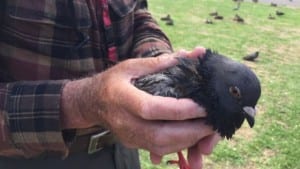
by Pigeon Patrol | Feb 4, 2016 | Bird Deterrent Products, Bird Netting, Pigeon Spikes
 Croke Park hit the headlines recently when the stadium decided to introduce a hawk to get rid of pigeons on the pitch.
Croke Park hit the headlines recently when the stadium decided to introduce a hawk to get rid of pigeons on the pitch.
Stadium Director at Croke Park Peter McKenna said recently that they’ve been running an acoustic system for a couple of months and that worked very successfully.
“It mimics a hawks cry and the birds disperse but then they become used to it.
“They’re probably not really pigeons either, they’re more kind of vermin. The wood pigeon which is a beautiful bird and probably very timid but these are a quasi-breed.
“All we want to do is scare them away, hopefully they’ll move across to Clonliffe College or some place like that and nest and roost in the trees there,” he said.
Martha Smithers, Stadium Operations at Croke Park, said that anything that can impact the pitch they take seriously.
“The pigeons are always present on the pitch, but the seed is a field day for them; it’s like dinner for them,” she said.
The introduction of a hawk at Croke Park has had an effect on pigeon numbers, Smithers said.
“The hawk has been flying for a while as a deterrent and as a bird of prey there has been a reduction in the numbers of pigeons on the pitch.
“Other methods we use are flying a hawk kite and noise. We’re constantly reseeding and constantly repairing; reseeding is vital at this time of year with the finals,” Smithers said.
With All-Ireland football matches coming up, blanket defences are sure to deter the pigeons and on September 6 at the All-Ireland Hurling Final there will be cats amongst the pigeons!
About Pigeon Patrol:
Pigeon Patrol Products & Services is the leading manufacturer and distributor of bird deterrent (control) products in Canada. Pigeon Patrol products have solved pest bird problems in industrial, commercial, and residential settings since 2000, by using safe and humane bird deterrents with only bird and animal friendly solutions. At Pigeon Patrol, we manufacture and offer a variety of bird deterrents, ranging from Ultra-flex Bird Spikes with UV protection, Bird Netting, 4-S Gel and the best Ultrasonic and audible sound devices on the market today.
Voted Best Canadian wholesaler for Bird Deterrent products four years in a row.
Contact Info: 1- 877– 4– NO-BIRD (www.pigeonpatrol.ca)

by Pigeon Patrol | Jan 30, 2016 | Bird Netting, Pigeon Patrol's Services, Pigeon Spikes, UltraSonic Bird Control
 Rick Gibson, UA Cooperative Extension
Rick Gibson, UA Cooperative Extension
Birds can devastate young vegetable seedlings or ruin fresh fruit in the blink of an eye but if we know what to do, and take action before they strike, we can often prevent problems.
Many of us are all too familiar with damage caused by birds to ripening apricots, plums, grapes and other garden fruits. We know it happens and even come to expect it. However, few people realize that birds can also seriously damage vegetable gardens. The fact is that yes, birds can make pests of themselves in vegetable gardens, particularly when young plants are in the seedling stage. Some people would be quick to say that they can be very aggravating pests. For those who know what I am talking about, I sense your frustration.
Birds can damage fruit and vegetables in two basic ways. The most obvious is direct feeding and the other is contamination of food products. Let’s consider some examples.
Horned larks are notorious in the commercial vegetable industry and in home vegetable gardens for nipping at new seedlings emerging from the ground. They usually don’t really eat the plant. Mostly they just bite it, perhaps for a taste of the sap. Sometimes though, they will pull it completely out of the ground. In these cases, it is not uncommon to find the poor, abused seedling lying discarded nearby after this not too gentle treatment. Horned larks are not the only ones that do this of course, but they are notorious for this kind of damage.
Other birds like finches, sparrows, thrashers and wrens will peck holes in the soft flesh of ripening fruit. Figs, apricots, peaches and plums are common targets for birds. Woodpeckers and their relatives, the sapsuckers, peck holes in the rinds of citrus fruit looking for a juicy taste of fresh fruit. Many birds figure out how to hunt the seeds that you just put in the ground and have lunch at your expense. If you are growing your own grains, watch out for the red-winged blackbird. They and their cronies will absolutely love your harvest.
Birds also cause damage to garden crops through direct contamination of the edible parts of the plant. Bird droppings are usually not a problem when they fall on fruits that will be peeled, but when they end up on difficult to wash fruit like blackberries, strawberries and clusters of table grapes, they make a real mess and the residues could harbor disease.
The sight of bird feces on fresh fruit is guaranteed to quickly destroy any desire one might have to pluck a ripe fruit and plop it directly in the mouth. Even so, most produce can be cleansed with a careful washing. In fact, it is a good idea to inspect food materials carefully before you place anything in your mouth. Even if you can’t see any contamination, it is always good to wash before you eat. It is better to be safe than sorry, I say.
How do we prevent bird problems in the garden? When thinking about control, many people quickly jump to the idea of chemical poisons and repellents. However, since most gardeners do not have the proper training, certification and license to use chemicals to control birds, that way is out. Don’t even think about it. Put it out of your mind. Don’t go there.
The same goes for shooting with fire arms, sling shots or arrows. There are a whole bunch of laws that if violated, could bring embarrassment, financial difficulties and even imprisonment. Unless you have legal permission, birds cannot be harmed in any way. Just so we are clear, almost every bird you see is protected by state and/or federal regulations. Killing or injuring birds without a license carries a stiff punishment and could get you into big trouble. Don’t do it.
So, what can you do to protect your garden from the ravages of hungry birds? There are a number of things that can be done and most fall within three categories: frightening devices, mechanical barriers and habitat modification.
Okay, let me emphasize right here that I am not recommending the use of loud sounds in populated areas to frighten away birds. While farmers out in the country might get away with propane cannons, fireworks and blank shotgun blasts, no one in the city wants to wake up to a loud bang or pop at the crack of dawn. Not only will the neighbors be upset, but the local law enforcement community also. They take a dim view of such activities, even if it is in the name of good gardening, because there are laws against disturbing the public peace.
On the other hand, a good predator silhouette works very well to frighten birds away. It is quiet and causes no harm to the animals. Some people use hawks or snakes, but I like to use an owl. Strategically placed and moved regularly, birds have a tough time telling the difference between a real owl and a plastic one in the few seconds they have to make a life or death decision. I really like the plastic owl that, with power from a solar collector, is able to move its head. Any movement is good because it gives the birds a more realistic view. I have seen birds literally do a U-turn in mid flight when they suddenly see what they think is a live owl hiding among the foliage of a fig or apricot fig. Predator images seem to work equally well in vegetable gardens.
Mechanical barriers are another good way to keep birds away from sensitive plants. Many people already use bird netting over citrus, apricots, grapes and plums to protect their fruit. Floating row covers, light spun fabric especially designed for agricultural use or the netting you use on your fruit trees can be set up to keep birds away from tender vegetable plants until they are large enough that birds lose interest. The floating row cover can be laid directly on top of the plants because they are light enough that they do not damage plants. Netting can be laid on top of a pole framework to keep them off the plants.
The last way to prevent bird damage is to change the natural habitat around your garden. Modifying conditions to make the area less interesting to the birds will help prevent bird populations from becoming excessive. The fewer the birds, the less damage will be sustained.
Of course, birds can travel some distance to a feeding area so habitat modification may have its limits, but anytime we can camouflage or make a feeding site less interesting, the better off we will be. Common modification techniques include removing roosting areas like trees and shrubs in the vicinity of the garden area, moving the bird bath and decorative bird houses to another part of the yard and eliminating nearby resting areas.
Birds cause many types of damage in the garden. While there are some things that we definitely should not do, there are steps that you and I can take to effectively prevent bird damage without harming protected species.
About Pigeon Patrol:
Pigeon Patrol Products & Services is the leading manufacturer and distributor of bird deterrent (control) products in Canada. Pigeon Patrol products have solved pest bird problems in industrial, commercial, and residential settings since 2000, by using safe and humane bird deterrents with only bird and animal friendly solutions. At Pigeon Patrol, we manufacture and offer a variety of bird deterrents, ranging from Ultra-flex Bird Spikes with UV protection, Bird Netting, 4-S Gel and the best Ultrasonic and audible sound devices on the market today.
Voted Best Canadian wholesaler for Bird Deterrent products four years in a row.
Contact Info: 1- 877– 4– NO-BIRD (www.pigeonpatrol.ca)
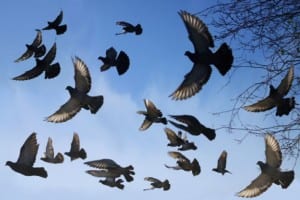
by Pigeon Patrol | Jan 29, 2016 | Bird Netting, Pigeon Spikes, Pigeons in the News, UltraSonic Bird Control
 They may only have a brain the size of a thimble, but it appears pigeons can categorise and name objects in the same way a human children learn new words.
They may only have a brain the size of a thimble, but it appears pigeons can categorise and name objects in the same way a human children learn new words.
A new study from the University of Iowa has shown that the birds are capable of learning to categorise 128 different photographs into 16 basic categories.
Scientists taught three pigeons to attribute different breeds of dog or types of shoe, for example to a particular symbol in exchange for a reward.
CROWS ARE PROBLEM SOLVERS
Crows are widely thought to be among the most intelligent of birds, but a recent study found they are even smarter than first thought, capable of solving complex tasks previously thought possible only by humans, apes and monkeys.
Most impressively, they performed the tasks spontaneously – without any prior training.
Two hooded crows were placed into a wire mesh cage into which a plastic tray containing three small cups was occasionally inserted.
The sample cup in the middle was covered with a small card that had a colour, shape or number of items pictured on it.
The other two cups were also covered with cards – one that matched the sample, and one that didn’t.
The cup under the matching card contained mealworms, which the crows were rewarded with if they chose the correct match.
The crows were then required to conduct a similar task but with images on cards that did not precisely match.
Researchers were surprised that the not only could the crows correctly perform these relational matches, with a success rate of 78 per cent – 50 per cent being regarded as chance – but that they did so spontaneously, without explicit training.
However, the researchers said it took their birds around 40 days to perfect the task of learning just 16 categories.
Professor Edward Wasserman, a psychologist at the University of Iowa who led the work, said: ‘Our birds’ rate of learning appears to have been quite slow. Human adults regularly learn 16 categories in the space of an hour, yet, pigeons took 45,000 trials to reach their associative limits.
‘Would children learn faster than pigeons? Almost certainly. However, our pigeons came to the experiment with literally no background knowledge.
‘They did not understand the nature of the “task”, they had not encountered these categories before, and they had empty lexicons.
‘Children, on the other hand, bring all of these things to bear on the problem of learning words.
‘Thus, the more relevant comparison group may be newborn infants, who indeed take 6–9 months to learn their first words.’
On each training day, the researchers presented each of the pigeons with 128 randomly ordered images.
Each image fitted into one of 16 categories – baby, bottle, cake, car, cracker, dog, duck, fish, flower, hat, key, pen, phone, plan, shoe, tree.
The birds then had to peck on one of two different colour symbols presented to them on a touchscreen computer – one that was associated with the correct category and the other the wrong category.
If the birds selected the correct symbol they were rewarded with a pellet of food. Incorrect choices plunged the birds into darkness foir a new seconds.
After the training, the birds were then presented with images from the categories they had not seen before to see if they could correctly attribute them.
Pigeons are known for their ability to find their way home, but the new study suggests they are even smarter
One of the birds reached an accuracy of 80 per cent, a second achieved 70 per cent accuracy and the third was 65 per cent accurate.
Writing in the journal Cognition, the researchers said their experiment was a very simple mirror of the way children are taught words – by their parents pointing to pictures and asking them to name the object.
They said: ‘Our paradigm is not a direct analog of human word learning.
‘Nevertheless, it does offer a unique biological model of a critical property of word learning – namely, the fact that a learner must map many exemplars to many categories.’
Professor Wasserman added: ‘Unlike prior attempts to teach words to primates, dogs, and parrots, we used neither elaborate shaping methods nor social cues.
‘Our pigeons were trained on all 16 categories simultaneously, a much closer analog of how children learn words and categories.
‘Differences between humans and animals must indeed exist – many are already known – but, they may be outnumbered by similarities.
‘Our research on categorization in pigeons suggests that those similarities may even extend to how children learn words.’
The scientists taught the pigeons to group images of real objects into the 16 distinct categories shown above
Pigeons are known to be smarter than many birds and their homing instinct allows them to memorise their location and find their way home from hundreds of miles away.
Professor Bob McMurray, another psychologist who took part in the study, said the results showed that human learning is not as unique as was previously believed.
He said: ‘Children are confronted with an immense task of learning thousands of words without a lot of background knowledge to go on.
‘For a long time, people thought that such learning is special to humans.
‘What this research shows is that the mechanisms by which children solve this huge problem may be mechanisms that are shared with many species.’
CROWS ARE ‘LEFT-BEAKED’ OR ‘RIGHT-BEAKED’
Researchers studying New Caledonian crows recently discovered the clever corvids display a preference for holding a stick tool on a certain side of their beaks – and this could be to make the most of their wide field of vision.
The researchers believe the birds may be trying to keep the tip of the stick in view of the eye on the opposite side of their heads, so they can see clearly in order to use tools in the most dexterous way.
Lead scientist Dr Alejandro Kacelnik, from Oxford University, said: ‘If you were holding a brush in your mouth and one of your eyes was better than the other at brush length, you would hold the brush so that its tip fell in view of the better eye. This is what the crows do.’
New Caledonian crows surprised experts with their ability to use sticks to extract larvae from burrows and, in captivity, retrieve food placed out of reach.
The study, published in the journal Current Biology, also suggests that the birds’ unusually wide field of vision actually helps them to see better with one eye.
About Pigeon Patrol:
Pigeon Patrol Products & Services is the leading manufacturer and distributor of bird deterrent (control) products in Canada. Pigeon Patrol products have solved pest bird problems in industrial, commercial, and residential settings since 2000, by using safe and humane bird deterrents with only bird and animal friendly solutions. At Pigeon Patrol, we manufacture and offer a variety of bird deterrents, ranging from Ultra-flex Bird Spikes with UV protection, Bird Netting, 4-S Gel and the best Ultrasonic and audible sound devices on the market today.
Voted Best Canadian wholesaler for Bird Deterrent products four years in a row.
Contact Info: 1- 877– 4– NO-BIRD (www.pigeonpatrol.ca)

by Pigeon Patrol | Jan 27, 2016 | Bird Netting, Pigeon Patrol's Services, Pigeon Spikes
 Some very interesting new research has uncovered something remarkable about pigeons. Apparently, they can learn much like a human.
Some very interesting new research has uncovered something remarkable about pigeons. Apparently, they can learn much like a human.
“The research shows the mechanisms by which children learn words might not be unique to humans,” comments study author Bob McMurray, of the University of Iowa. “Children are confronted with an immense task of learning thousands of words without a lot of background knowledge to go on. For a long time, people thought that such learning is special to humans.”
McMurray goes on to say, “What this research shows is that the mechanisms by which children solve this huge problem may be mechanisms that are shared with many species.”
Obviously, a pigeon does not have the same capacity for information as a human, but the study suggest that they have, at least, comparable capacity for learning.
“It is certainly no simple task to investigate animal cognition; but, as our methods have improved, so too have our understanding and appreciation of animal intelligence,” explains study author Ed Wasserman, of the University of Iowa. “Differences between humans and animals must indeed exist, many are already known. But, they may be outnumbered by similarities. Our research on categorization in pigeons suggests that those similarities may even extend to how children learn words,”
He presents hypotheticals: “Would children learn faster than pigeons? Almost certainly; However, our pigeons came to the experiment with literally no background knowledge. They did not understand the nature of the ‘task’ they had not encountered these categories before, and they had empty lexicons.”
“Children, on the other hand, bring all of these things to bear on the problem of learning words,” he says. “Thus, the more relevant comparison group may be newborn infants, who indeed take 6 to 9 months to learn their first words.”
About Pigeon Patrol:
Pigeon Patrol Products & Services is the leading manufacturer and distributor of bird deterrent (control) products in Canada. Pigeon Patrol products have solved pest bird problems in industrial, commercial, and residential settings since 2000, by using safe and humane bird deterrents with only bird and animal friendly solutions. At Pigeon Patrol, we manufacture and offer a variety of bird deterrents, ranging from Ultra-flex Bird Spikes with UV protection, Bird Netting, 4-S Gel and the best Ultrasonic and audible sound devices on the market today.
Voted Best Canadian wholesaler for Bird Deterrent products four years in a row.
Contact Info: 1- 877– 4– NO-BIRD (www.pigeonpatrol.ca)
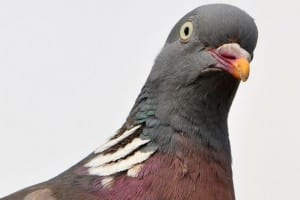
by Pigeon Patrol | Jan 26, 2016 | Bird Netting, Pigeon Spikes
 Two Aeroflot jets collided with birds in the past 24 hours, but no one was injured.
Two Aeroflot jets collided with birds in the past 24 hours, but no one was injured.
The pilots of an Airbus A-330 radioed air traffic controllers shortly after taking off from Moscow’s Sheremetyevo Airport on a flight to London to say that they had struck a large bird, Interfax reported Thursday.
“Nonetheless, the crew decided to continue the flight,” an official in Moscow’s air traffic control was quoted as saying.
The plane departed Moscow at 8:45 p.m. Wednesday. No serious damage was discovered to the aircraft after it safely landed in Heathrow.
The report did not say how many people were aboard the jet, which typically can carry 250-300 passengers.
The second bird strike occurred as an Airbus A-321 flight from Moscow was preparing to land at the Kaliningrad airport at 3:40 p.m. Wednesday. The bird hit the cockpit’s windshield, Moscow’s air traffic control said, without elaborating on whether the windshield was damaged.
Interfax did not say how many people were on the flight.
About Pigeon Patrol:
Pigeon Patrol Products & Services is the leading manufacturer and distributor of bird deterrent (control) products in Canada. Pigeon Patrol products have solved pest bird problems in industrial, commercial, and residential settings since 2000, by using safe and humane bird deterrents with only bird and animal friendly solutions. At Pigeon Patrol, we manufacture and offer a variety of bird deterrents, ranging from Ultra-flex Bird Spikes with UV protection, Bird Netting, 4-S Gel and the best Ultrasonic and audible sound devices on the market today.
Voted Best Canadian wholesaler for Bird Deterrent products four years in a row.
Contact Info: 1- 877– 4– NO-BIRD (www.pigeonpatrol.ca)
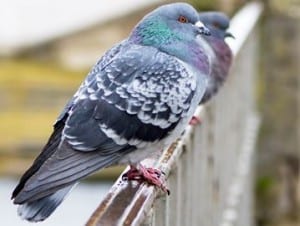
by Pigeon Patrol | Jan 22, 2016 | Bird Deterrent Products, Bird Netting, Pigeon Spikes
 A PIGEON was killed by a man in Exeter after it pecked at scraps from his hotdog, a court heard.
A PIGEON was killed by a man in Exeter after it pecked at scraps from his hotdog, a court heard.
Exeter Magistrates’ Court heard the incident took place near Castle Street in the city on St Valentine’s Day last month, when a member of the public witnessed Jeremy Wayle, 48, of Totnes, crush the bird under his foot outside the cafe.
Appearing before magistrates Wayle pleaded guilty to killing a non schedule one wild bird, and through his solicitor said he “accepted it should not have happened and his behaviour was wholly unacceptable.”
The court heard Wayle had been having a nice day until he started eating a hot dog and a flock of pigeons descended near him.
Irritated by the avian invasion, he trapped one of the birds under his foot and crushed it to death, causing “shock and distress” to a female shopper.
The woman confronted him telling Wayle he was “nasty,” the court heard.
Wayle told the woman that pigeons were vermin.
Police were called and Wayle, who is unemployed, was searched and found to have a small amount of cannabis on him.
In mitigation, the court heard he suffered a head injury 30 years ago and had suffered from post-traumatic stress disorder. Magistrates heard he did not want to upset anyone and was very apologetic for his behaviour.
Wayle, was given a conditional discharge for 12 months, ordered to pay £15 to the court and had cannabis was forfeited and ordered to be destroyed.
About Pigeon Patrol:
Pigeon Patrol Products & Services is the leading manufacturer and distributor of bird deterrent (control) products in Canada. Pigeon Patrol products have solved pest bird problems in industrial, commercial, and residential settings since 2000, by using safe and humane bird deterrents with only bird and animal friendly solutions. At Pigeon Patrol, we manufacture and offer a variety of bird deterrents, ranging from Ultra-flex Bird Spikes with UV protection, Bird Netting, 4-S Gel and the best Ultrasonic and audible sound devices on the market today.
Voted Best Canadian wholesaler for Bird Deterrent products four years in a row.
Contact Info: 1- 877– 4– NO-BIRD (www.pigeonpatrol.ca)

 Croke Park hit the headlines recently when the stadium decided to introduce a hawk to get rid of pigeons on the pitch.
Croke Park hit the headlines recently when the stadium decided to introduce a hawk to get rid of pigeons on the pitch.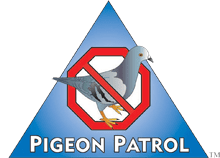

 Rick Gibson, UA Cooperative Extension
Rick Gibson, UA Cooperative Extension
 They may only have a brain the size of a thimble, but it appears pigeons can categorise and name objects in the same way a human children learn new words.
They may only have a brain the size of a thimble, but it appears pigeons can categorise and name objects in the same way a human children learn new words.
 Some very interesting new research has uncovered something remarkable about pigeons. Apparently, they can learn much like a human.
Some very interesting new research has uncovered something remarkable about pigeons. Apparently, they can learn much like a human.
 Two Aeroflot jets collided with birds in the past 24 hours, but no one was injured.
Two Aeroflot jets collided with birds in the past 24 hours, but no one was injured.
 A PIGEON was killed by a man in Exeter after it pecked at scraps from his hotdog, a court heard.
A PIGEON was killed by a man in Exeter after it pecked at scraps from his hotdog, a court heard.